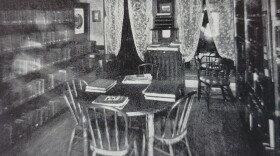Today we view Halloween as a harmless holiday where young children dress up in colorful costumes and go door-to-door in the early evening asking neighbors for candy treats. In the past, however, the night before All Saints Day on November 1st, or All Hallows Eve, was the time when people believed that the boundary between the worlds of the living and the dead became blurred. Ancient Celts thought that this was the night when ghosts walked freely upon the Earth.
Even though beliefs changed over time, All Hallows Eve became the night when real-life pranksters took on the work of mischievous spirits to play tricks on unsuspecting neighbors. Halloween became a moral holiday for teenagers; that is, for one night, acts of petty vandalism were tolerated. Teenagers tipped over outhouses, knocked over woodpiles, and soaped windows, among other things.
Sometimes the vandalism became a little too destructive, and during the first decades of the twentieth century people wondered if the Halloween holiday should be reformed. These calls become increasingly intense throughout the 1920s, and by the 1930s people in Rhinelander decided to try something different. It was considered newsworthy enough that papers as far south as Madison carried reports of Rhinelander’s Halloween proposal.
In 1931, the Boy Scouts led the charge to stop mischief and property damage while straightening out Rhinelander’s Halloween pranksters. The plan, which was worked out in conjunction with the City Council, was to organize a night of entertainment for young and old alike. Providing entertainment for adults was necessary because, as one committee member pointed out, three married women were caught soaping windows on Brown Street the previous year.
One idea was to open the doors of the State and Majestic theaters to allow free movies for the community, but Halloween fell on a Saturday that year and the theater owners balked at the idea of losing a prime business day. Instead, the committee secured the use of the Oneida Memorial Building. The potato show equipment was removed and the building converted into the home of Rhinelander’s first community Halloween festival.
The festivities started at 7:30 p.m. A community-wide parade led by the City Band, followed by the Boy Scouts then young and old alike in full costume, started on North Brown Street, marched through the downtown district, rounded onto Stevens Street, then up to the Memorial Building.
Once in the Memorial Building, the children were taken to the basement and treated to a two-reel comedy short called Tomato Omelette, which was followed by some old-time movie and vaudeville slides provided by the Great Lester. Even though minstrel shows were out-of-style by the 1930s, the highlight for the children was a show of singing, dancing, and jokes provided by the Jim Williams Minstrel Show Company performing in blackface. On the main floor, the adults were treated to a carnival of game booths and a dance.
Did the idea work? On Monday Rhinelander police reported that vandalism dropped considerably because of the community party. The idea was not carried over into 1932 and the pranks resumed.









